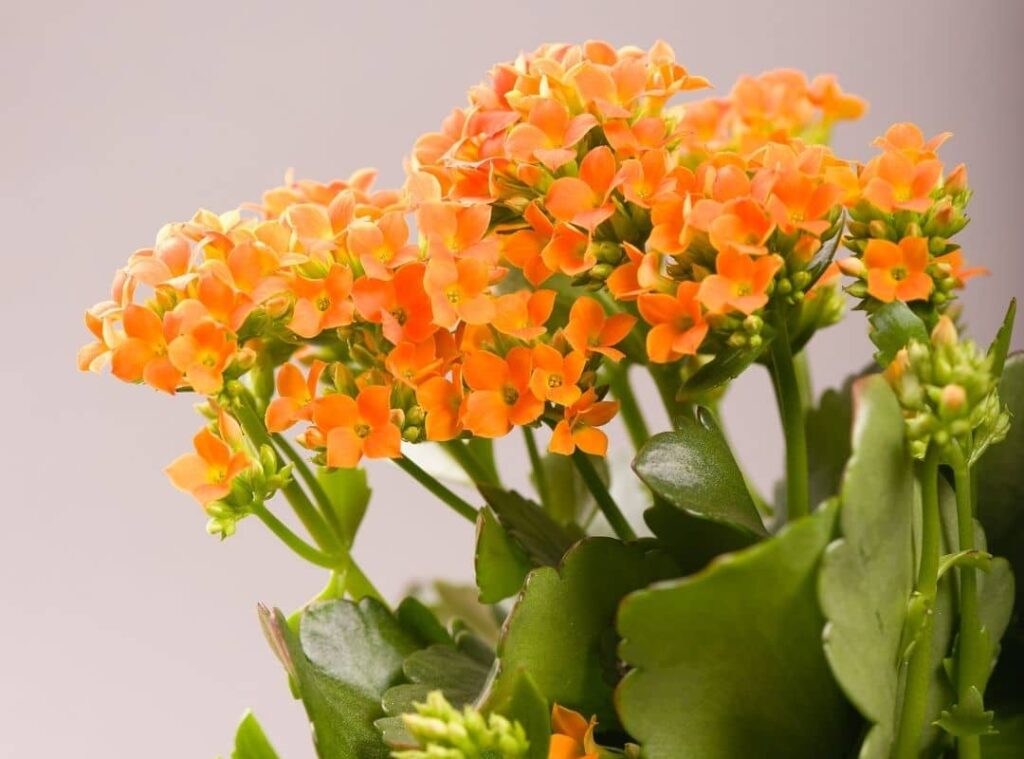If you are wondering how to propagate flaming katy plants, there are three ways of mainly doing it.
Basically, you could conduct flaming katy propagation by using stem cuttings, offsets and using their seeds too. We will learn about each subject in detail as we proceed in this article.
To briefly explain on the flaming katy plant, they are native to Madagascar. Many people tend to grow them as indoor plants.
You could grow them outdoors if you live in USDA hardiness zones 10 and 11. They bloom in the winter season. Flaming katy plants usually consist with thick leaves and with fragile stems as well.

Flaming katy propagation via Stem cutting
They could root from vegetative shoots and many people use this method to propagate flaming katy.
On the other hand, commercial growers use intermittent mist and heat mats for the propagation of flaming katy plants.
However you could make the cuttings without the professional setups as well.
First, make the cutting of the vegetative stem of the flaming katy plants. This stem should not have any flower growth.
The length of the cutting should be about 3 inches (7.5 cm). After you cut the stem, you could place the cutting in an empty pot for a couple of days.
That will allow the cut edges to become callous. When it becomes callous, it will avoid any potential rotting once you grow them in the potting medium.
When you make the potting medium, you should blend perlite, sand, and peat moss in even amounts. That will make a perfect soil mix for these plants to grow.
Take a sterilized pot and add some of the aforesaid potting medium and water them lightly. Depending on the pot size, you could select the number of cuttings you are going to place for rooting.
In general context, pots 3 or 4 inches in size could hold one cutting. On the other hand, pots which are about 5-6 inches in size could withstand 2-3 cuttings.
Thirdly, dig a hole in the soil mix of the pot and stick the stem cuttings there. When you place them, make sure that you place the calloused edges in the pot.
Make sure those cuttings are well established in the soil mix. After that you should keep the pot in a bright sunny location where they expose for an average temperature of 70 degrees Fahrenheit. Keep in mind to not expose them to direct sunlight.
Fourthly, you could mist the cuttings a few times on a daily basis. In case you spot any fungal growth, you need to immediately take them out from the pot.
Keep those under your observation for a couple of weeks. You could check whether the roots have established by gently trying to push them from the pot and see.
If you feel like they are more resistant, roots have already formed on a significant scale.
Finally, you could transplant the new flaming katy plants in individual pots once the roots are about 1 inch (2.5cm) long.
During the first few weeks, you should treat them as seedlings. To elaborate further on this, refrain from exposing them under direct sunlight, drought conditions.
Once you spot the new growth of the flaming katy plants, you could place them wherever you wish to have them. After that continue with the regular care treatments for the plants.
Flaming katy propagation via Offsets
If you wish to propagate the flaming katy plants through offsets, you need to first wait for several years until the mother plants produce offsets.
So, to begin with you could use a knife and take off an offset from the mother plant. Make sure that you are using a clean and sharp knife to take off the offsets.
Once you obtain the offsets, first you need to get rid of the old soil around the offsets. After that you need to wait for some days so that the cut edges become callous.
After that, you could place those offsets in a well-draining soil mix. You may water those once the soil is in dry condition.
Flaming katy propagation via Seeds
Flaming katy plants are a set of slow growing plants.
So, even though you could use their seeds for the propagation of the flaming katy plants, I would not recommend that as we cannot guarantee the results.
However, if you wish to propagate them through seeds, you could simply place them in a well-draining soil mix. In fact, the best is to try this method outdoors.
If you live in cooler areas you could go ahead with the indoor propagation methods as aforesaid,

How to treat after propagation
Watering
Just like with watering the rest of the succulents and the cactus, you should water the flaming katy plants only when their top layer of the soil is dry in condition.
These plants usually could withstand the drought conditions. They would thrive well even though you forget to water them. As such they would perfectly fit for a forgetful gardener.
Over watering is the biggest mistake you would make when growing the flaming katy plants. Further it is a common mistake that many of you come across as well.
If you over water these plants, they would be quite attractive for pests such as powdery mildew. Apart from that, diseases such as root rots are some more side effects of over watering. As such, watering them properly is very important.
Apart from that, be mindful not to water them on their leaves. They have densely grown foliage and once you pour water at them, there will be an unwanted water pool building up .
That will attract fungus and make the plant vulnerable for other diseases as well.
When it comes to watering them during their flowering season, you need to water them a little more as they want more water due to the increased level of water loss. Having said that, you still need to check on the soil condition and water them.
Sunlight
You need to provide bright and indirect sunlight for the flaming katy plants for their survival. If you are growing them as indoor plants, you should place them near a bright and sunny window.
Do not ever expose these plants under scorching sun for longer periods and for intense heat as that would lead to sunburns in the plant.
Moreover, they can withstand direct sunlight for about a couple of hours daily. It could ideally be the morning sunrise or the late evening sunshine.
You could leave them in a shady place for the rest of the day. During the summer season, you could shift the plants outdoors.
When you bring them outdoors, you need to make sure that you are placing them in a shady place where they get 1-2 hours of direct sunlight.
When you place them outdoors, it would be beneficial for the plant to grow vigorously. Apart from that, their vegetative growth could also be benefited from this. Further it would be useful for the flower blossoming too.
Avoid exposing these plants to temperatures below 50 degrees Fahrenheit. Hence if you have grown them outdoors, bring them indoors when the temperature decreases.
Soil
It is mandatory that you provide a well-draining soil mix. Ideally it has to be a sandy, lightweight loose soil medium.
Avoid growing them in hard packed clay as it would make the roots difficult to penetrate. These plants would thrive in salty soil mix as well.
You could further add some moisture retaining substances in the soil mix too. coconut coir would suit this requirement. You could also add perlite instead of that too.
Fertilizer
Best is to use a balanced fertilizer during their growing season to feed them. That would help to boost the flowering of the plant as well.
If you wish to boost the flowering of the plant, you could use a fertilizer which has a high level of phosphorus.
Moreover, if you are using a slow-release fertilizer, you need to follow the labeled guidelines.
On the other hand, if you are using a liquid fertilizer, you could dilute it and apply it at the plant once every two weeks’ time.
Read More Can You Propagate A Panda Plant? | 2 Effective Ways |
Read More Pencil Cactus Propagation Guide | 4 Effective Way To Propagate
Read More Conophytum Propagation Guide | 4 Effective Ways To Propagate |
